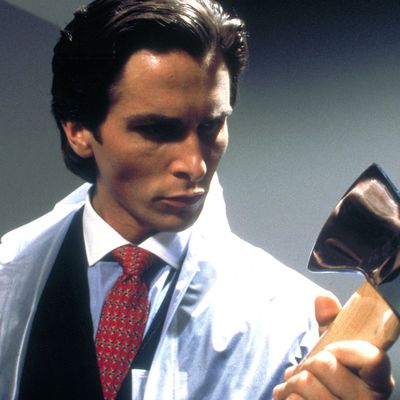
Bret Easton Ellis’s 1991 novel American Psycho is about a Wall Street hotshot and serial killer whose life is a fetish of conspicuous consumption. Patrick Bateman – note the reference to Norman Bates of Psycho – is all roiling surface, and Ellis expends reams of prose cataloguing the man’s designer preferences for everything from gazelle-skin wallets to crocodile loafers. The conceit is that Bateman the trendoid couture lunatic is a metaphor for the self-aggrandizing yuppie creep made possible by the Reagan eighties. He’s the Frankenstein monster the Gipper hath wrought. Ellis may have intended the book as Swiftian satire, but his metaphor is none too swift. Extending the thrill of investment upswings to include the thrill of murder, he misses out on the biggest joke of all – that a killing on Wall Street would make actual killing redundant for a guy like Bateman. The book, despite its wry mordancy, is opportunistic in a flashy, high-concept way, an excuse to buy off blood-bucket porno pulp by toning up its social pedigree.
American Psycho, the movie that director and co-screenwriter Mary Harron has made from the novel, pares down Ellis’s numbing, voluminous cataloguing and, mercifully, also tamps down his goriest passages. (The film is still pretty icky.) Clearly, Harron is sold on the Bateman-as-metaphor bit, and, like Ellis, she overconceptualizes everything: Bateman, played by Christian Bale, is all of a piece with his off-white Upper West Side apartment and his deep-cleansing face mask. He’s a buff hologram inside a product-placement universe (although, for obvious reasons, the actual products being placed are, by current movie standards, relatively few – a great inadvertent joke). Bale is a good choice to play Bateman, because his florid, sharply cut handsomeness already has a jolt of the sinister about it. When Willem Dafoe turns up playing a private investigator, he looks so much like Bateman that the film begins to resemble a convention of gargoyles. Haven’t we already been here with David Cronenberg?
The time to have made this movie was back in the early nineties, when master-of-the-universe misogyny and murderous manners were at their peak. Since then, the money culture has changed. The market is no longer the near-exclusive province of gentrified yups and alpha males; it’s more like the national pastime – who wants to be a millionaire? – and even small-timers can get into the game. The snob-appeal acquisitiveness that is so hilariously nightmarish in both the book and the movie doesn’t look so threatening anymore (although the rise over the past decade in obnoxious cell-phone usage could easily justify for me an American Psycho II). All this may change, of course: Boom times come and go. But for better or for worse, it’s the wrong cultural moment to be demonizing Wall Street, or, for that matter, New York, which is portrayed as the den of perdition from which all this horror bubbles up. Without this demonization working for it, American Psycho is left to fall back on the blood lust of its monster. And because the monster is deliberately depicted without psychological depth, the movie, for all its fussy pretensions, resembles nothing so much as a classy slasher flick.

